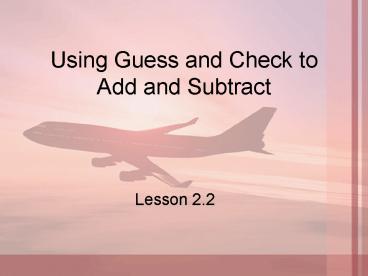Using Guess and Check to Add and Subtract - PowerPoint PPT Presentation
1 / 9
Title:
Using Guess and Check to Add and Subtract
Description:
... Add and Subtract. Lesson 2.2. Problem Solving Method. Understand. Plan. Solve. Look ... The best way to attack a guess and check problem is to make a table. ... – PowerPoint PPT presentation
Number of Views:147
Avg rating:3.0/5.0
Title: Using Guess and Check to Add and Subtract
1
Using Guess and Check to Add and Subtract
- Lesson 2.2
2
Problem Solving Method
- Understand
- Plan
- Solve
- Look Back
3
Example 1
- During an annual reading program, the sixth and
seventh graders read 1,020 books. The sixth
graders read 110 more books than the seventh
graders. How many books did the sixth graders
read? How many books did the seventh graders read?
4
Understand
What am I supposed to find?
1.
How many books the 6th graders read.
2.
How many books the 7th graders read.
What facts are given?
1,020 books were read in all.
1.
2.
The 6th graders read 110 more books than the 7th
graders.
5
Plan
What strategy can I use?
- We know that the sum of the books is 1,020
(thats how many were read in all), and that the
difference is 110 (thats how many more the 6th
graders read). - We have 2 clues (sum and difference) so we can
use the guess and check method. - We will make a guess that satisfies the sum, then
check to see if it satisfies the difference.
6
Solve
How will I solve this problem?
- The best way to attack a guess and check problem
is to make a table. - Remember, our two numbers have to add to 1,020
and subtract to 110.
7
Solve
1,020 - Sixth Grade Seventh Grade
Sum (1,020)
Sixth Graders
Seventh Graders
Difference (should be 110)
Does this work?
1,020
500
520
520 - 500 20
No, too small.
1,020
600
420
600 - 420 180
No, too big.
1,020
550
470
550 - 470 80
No, too small
1,020
560
460
560 - 460 100
No, too small.
1,020
565
455
565 - 455 110
Yes, the sum is 1,020 and the difference is 110.
8
Look Back
- Lets be sure we answer the questions
- The 6th graders read 565 books.
- The 7th graders read 455 books.
When my difference was too small, I increased the
number of books read by the 6th graders. When
the difference was too big, I decreased the
number of books. I did this until I came up with
the answer.
9
Lets try some on our own!































